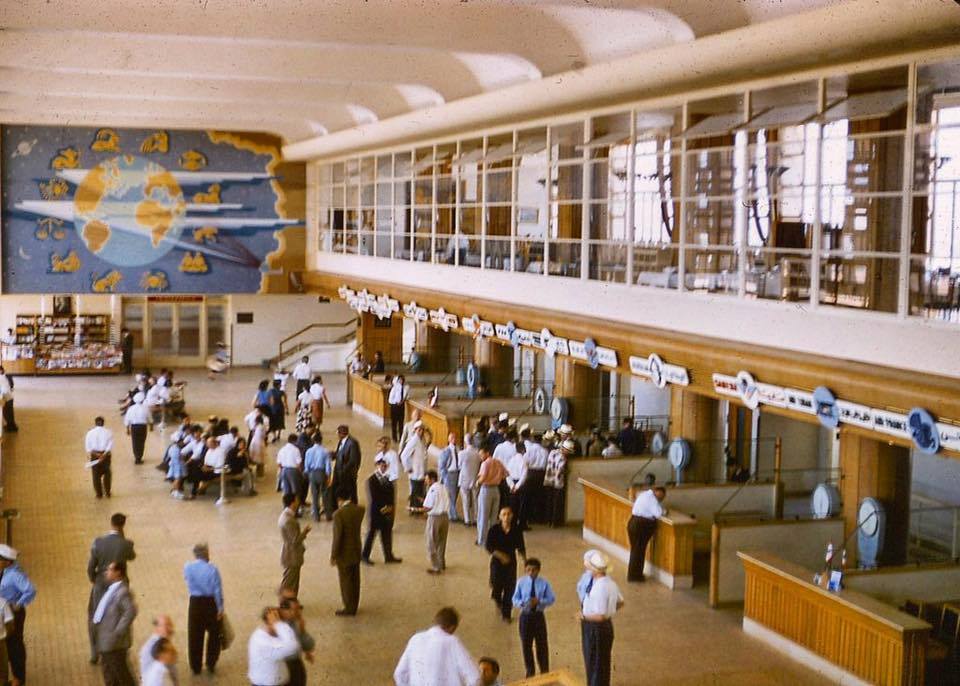Built on a stretch of sand dunes by the Mediterranean sea, with mountains to the east and north and a mere eight kilometers from the city, the former terminal of Beirut International Airport was a showcase for a newly independent country. The 1950s-style airport was the glamorous entry point to a small nation striving toward modernity and social change, with a national airline that championed a non-sectarian ethos. When Lebanon became enmeshed in an interminable civil war, its inhabitants counted on the airport and Middle East Airlines to get them to safety, and for Lebanese flying home, the terminal also came to symbolize familiarity, even pockmarked with bullet holes. When the old terminal was razed to make way for the new Rafic Hariri International Airport, eight years after the end of the Lebanese civil war, many felt a sadness, and nostalgia for a way of life that was not to be.
Officially inaugurated in April 1954, Beirut International Airport replaced Bir Hassan airport, which had become too small when Beirut became a convenient stopping point between Europe, Asia, and Africa. In the 1930s, air service to Beirut had involved seaplanes disembarking passengers at the St Georges Bay wharf, site of the legendary St Georges hotel built in the 1920s to host Hollywood stars and international royalty, and which would later become a hangout for the double agent Kim Philby. When the French mandate concluded in 1943 and after World War II came to an end, Middle East Airlines (MEA) was founded. The country’s economy was rapidly expanding, and air travel to the capital became increasingly important; MEA would survive takeovers and mergers to became the country’s major carrier, and the country’s largest employer, and be inextricably linked to the airport.
The three-story terminal was modern for its time, designed by a French architecture firm. On the first floor there was a restaurant and a coffee shop run by Le Bristol, a luxury hotel that had opened several years earlier. There was a terrace where people could see the two asphalt runways and watch the airplanes land and taxi to the gates. Besides the airlines from other Middle Eastern countries, all major European companies as well as Australian and Brazilian airlines stopped in Beirut.
 Lebanese Ministry of Tourism
Lebanese Ministry of Tourism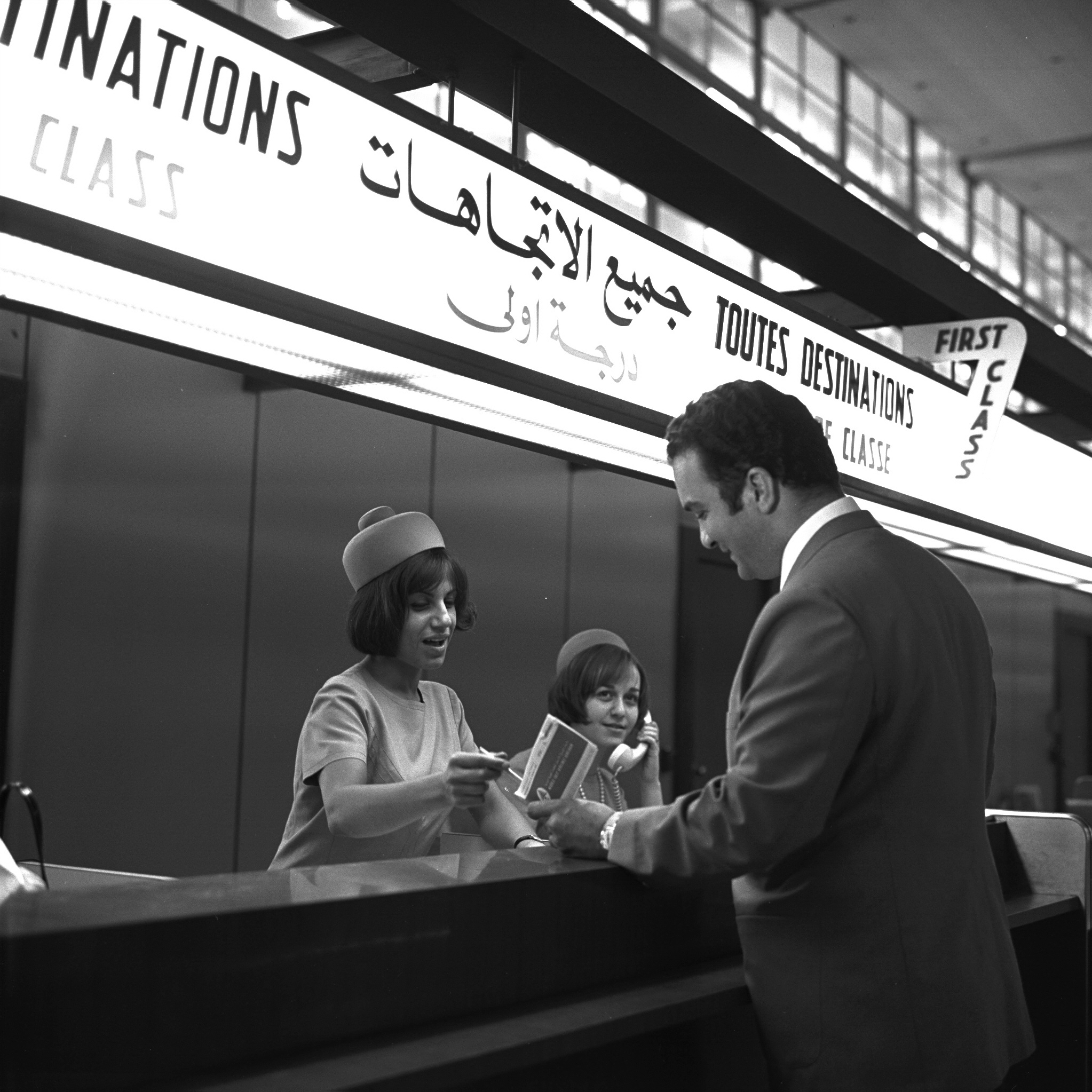 Lebanese Ministry of Tourism
Lebanese Ministry of Tourism“The Beirut airport was something new in the area,” recalled Captain Amin Al Habbal, a retired MEA pilot who spends many a morning with his former colleagues discussing aviation and reminiscing. “At that time, we had no radar, just one radio. It was rare to have a good airport equipped with a restaurant and a café. In the afternoon, people would come to have coffee and ice-cream. We had a special corner in the café where most of the pilots transiting through the airport would gather. They used to bring school children on class trips, mainly boys, to see the airport and the control tower.”
Nadim Shehadeh, now an economist and scholar, was one of those boys: “My school was near the airport. I remember the terrace. In those days when an emigrant would return, you literally had the whole village that would come by bus to greet them. It was also the first place that had the soft ice cream we called ‘Merry Cream.’”
“It was a beautiful little airport,” Jonathan Randal, who reported for The Washington Post from Beirut between 1974 to 1983, told me. “In 1970 I would fly to Cairo from Beirut and leave at 6 in the morning, report all day and fly back to Beirut and file my story because it was the only way to get around the [Egyptian] censors.”
In the early 1970s the designer Michel Harmouch was brought in to give the terminal a modern, yet local facelift in blue and silver tones; there were recesses in the shape of cypress trees and an enormous chandelier in blown glass and metal. The restaurant was taken over by Albert Abela, who ran a catering company that was expanding worldwide.
“I remember the terminal so well and that chandelier,” said Lamia Ziadé, an artist and writer. “It was totally wild. You don’t see anything like that anymore in airports today.”
“You would fly 1st class and MEA would give you matchbooks embossed with your name in gold,” Randal remembered. “That was before everything went to hell.”
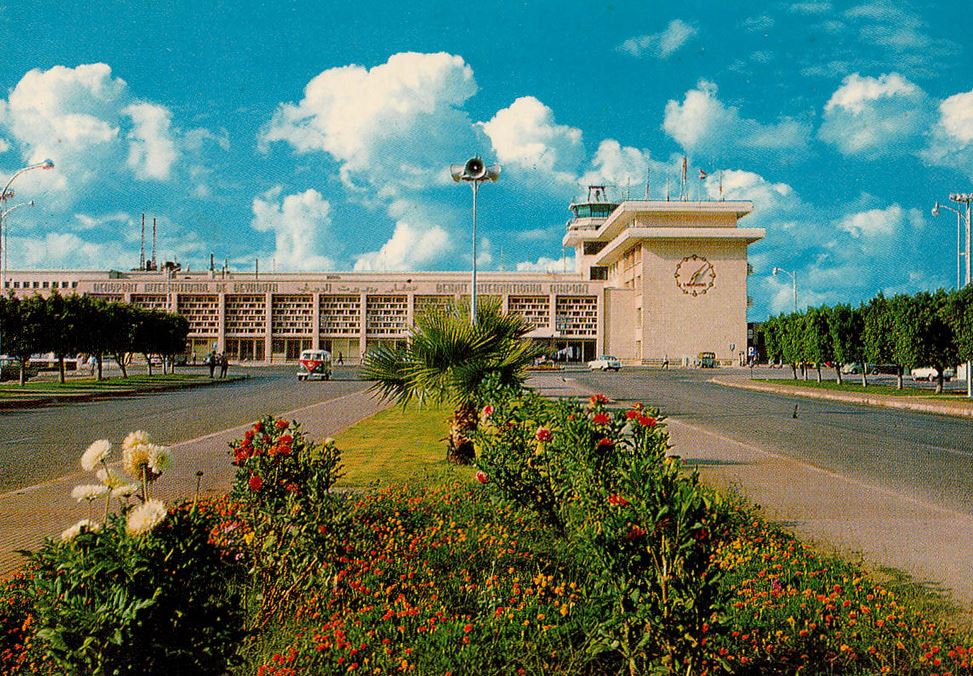 Lebanese Ministry of Tourism
Lebanese Ministry of TourismBefore everything went to hell, Lebanon exuded glamor and had just the right touch of exoticism for Westerners. MEA became the Middle Eastern airline, its maintenance center was used by foreign airlines; as the region’s most important hub, the Beirut airport appeared in euro spy films like Secret Agent Fireball, 24 hours to Kill, and La Grande Sauterelle (The Tall Grasshopper). But the glamor faded briefly as you left the airport; just outside were the Palestinian refugee camps of Shatila and Bourj al Barajneh.
“The camps became a familiar sight for air travelers,” as journalist David Ignatius wrote in Agents of Innocence, his 1987 spy novel set in Beirut in the late 1960s and 70s: “the MEA jets would turn right from the Mediterranean, begin their descent above the shops and cafés of Hamra Street, and roar over the miserable camps of Sabra and Shatilla, so close that the frail houses seemed to shake and then touch down their wheels in the Paris of the Orient.”
The Beirut airport’s first taste of violence from the Israel-Palestine conflict was in 1968, when an Israeli commando blew up fourteen planes on the ground, in response to an attack in Athens on an Israeli passenger jet by the Lebanon-based Popular Front for the Liberation of Palestine. Ten out of the fourteen planes demolished belonged to MEA. But it was only the first of many more incidents; in 1975, when the civil war began in Beirut and then spread to the rest of the country, a permanent state of violence set in.
MEA fought hard to remain neutral. MEA’s chairman until 1978 was Najib Alamuddin dubbed the “Flying Sheikh” by a British journalist, a title which stuck with him ever after. He had instilled in the employees a tradition of non-sectarian tolerance. Throughout the civil war, MEA operated with a rare socio-economic and religious mix of employees. But the city became increasingly divided along ethnic, religious, and socio-economic lines—with western Beirut controlled by Muslim militias and eastern Beirut in the hands of Christian militias—Christians had to risk crossing the demarcation line to get to the airport.
Captain Abdel Moneim Hoteit today runs an airplane-leasing business with other former MEA colleagues, all of whom met in the 1950s. It’s in his office just off Hamra Street that Captain Al Habbal and others hang out and received me. When the war began, Captain Hoteit told me, he reinforced the idea that MEA should remain neutral; “we were a national airline.” Dormitories were set up for staff from East Beirut, when it was too dangerous for them to go home.
“Most of the crew slept, ate and washed their dirty clothes at the airport,” said Captain Al Habbal.
In 1976 the airport had to close for a few days, and a photographer for An Nahar newspaper immortalized the moment in a fantastical photo of an errant horse wandering down the airport hall.
On the ground in West Beirut where life had become confined and sheltered, two small boys had discovered a way of traveling via their imagination. Gregory Buchakjian and Wassim Chemaitilly—best friends since they were five years old—shared a passion for airlines, airports, and MEA memorabilia that began at their school, which was directly beneath the flight path leading to the main landing runway. Along with a few classmates, Buchakjian and Chemaitilly knew exactly which airline was flying overhead and what aircraft, whether it was the Finnair flight, for example, and if it was a Boeing 720. “Sometimes there was something unexpected, like a transport plane, and that was very exciting,” Buchakjian, a Beirut-based art historian and visual artist told me,eyes still shining over 30 years later.
When they were ten years old, during a moment of calm amidst bouts of fighting, their school took them on a rare field trip to the airport which sealed their passion. “In hindsight,” said Chemaitilly, today a doctor in the US, “MEA was one of the only remaining organizations [during the war] that kept going for civil society.” The boys collected airline timetables and other paraphernalia, and even after Buchakjian moved to East Beirut, Chemaitilly continued to roam West Beirut, gathering timetables for airlines that no longer exist, such as Alyemda, the national airline of south Yemen, or Interflug, East Germany’s national airline. “It was a cheap hobby—it didn’t cost my parents anything and it kept me busy,” said Chemaitilly. His mother called his room ‘The Travel Agency.’
During the summer of 1982, the Israeli invasion of Lebanon closed the airport for 115 days, destroyed six MEA Boeings, and damaged the terminal, hangars, and offices. In Ari Folman’s animated war documentary, Waltz with Bashir, he recalls landing at the airport as a soldier: at first, he sees the departures board listing flights to London, Paris, or New York, and duty-free shops selling jewelry, tobacco, and alcohol. A moment later, he realizes that the shops have been closed and looted and the departures board is frozen.
The once-glamorous airport had become distinctly unglamorous, a gateway for emigration: close to 40% of the country’s population fled the war between 1975 and 1989, almost a million people. In Borhane Alaouié’s Beyroutou al lika (The Encounter, 1981), a man waits at the airport for a woman who is emigrating; Maroun Bagdadi’s Les Petites Guerres (Little Wars, 1982) shows friends parting at the airport; and in Hanan Al-Shaykh’s 1992 Beirut Blues, translated by Catherine Cobham, an entire chapter takes place in the airport. “The airport floor used to be light beige-coloured like sugar, sixties design, reminding you of those times,” as a character describes the terminal; “Now it had dark patches on it and there were cigarette butts everywhere as if the floor was a giant ashtray. A cloud of cigarette smoke hung permanently in the air, or was it just dark?”
When the airport was closed, passengers would travel to Damascus and fly from there. Many Christians would take a ferry boat from the port of Jounieh to Larnaca, in Cyprus. At one point there were plans to develop a military landing strip 20 kilometers north of Beirut to serve the Christian area, but it never opened to civilian traffic.
“The airport was essential,” said Jonathan Randal. “When it was closed down by any number of rebel groups it was terrible. It was the only city in the world where a passenger plane flying overhead was a happy occasion because it meant the airport was open.”
Through it all, Middle East Airlines soldiered on, at one point relocating its operations to Paris’ Orly airport. By the mid-1980s, MEA was the only carrier serving Beirut, but when it was possible to fly MEA planes, they flew, even amidst rocket fire and mortar shells.
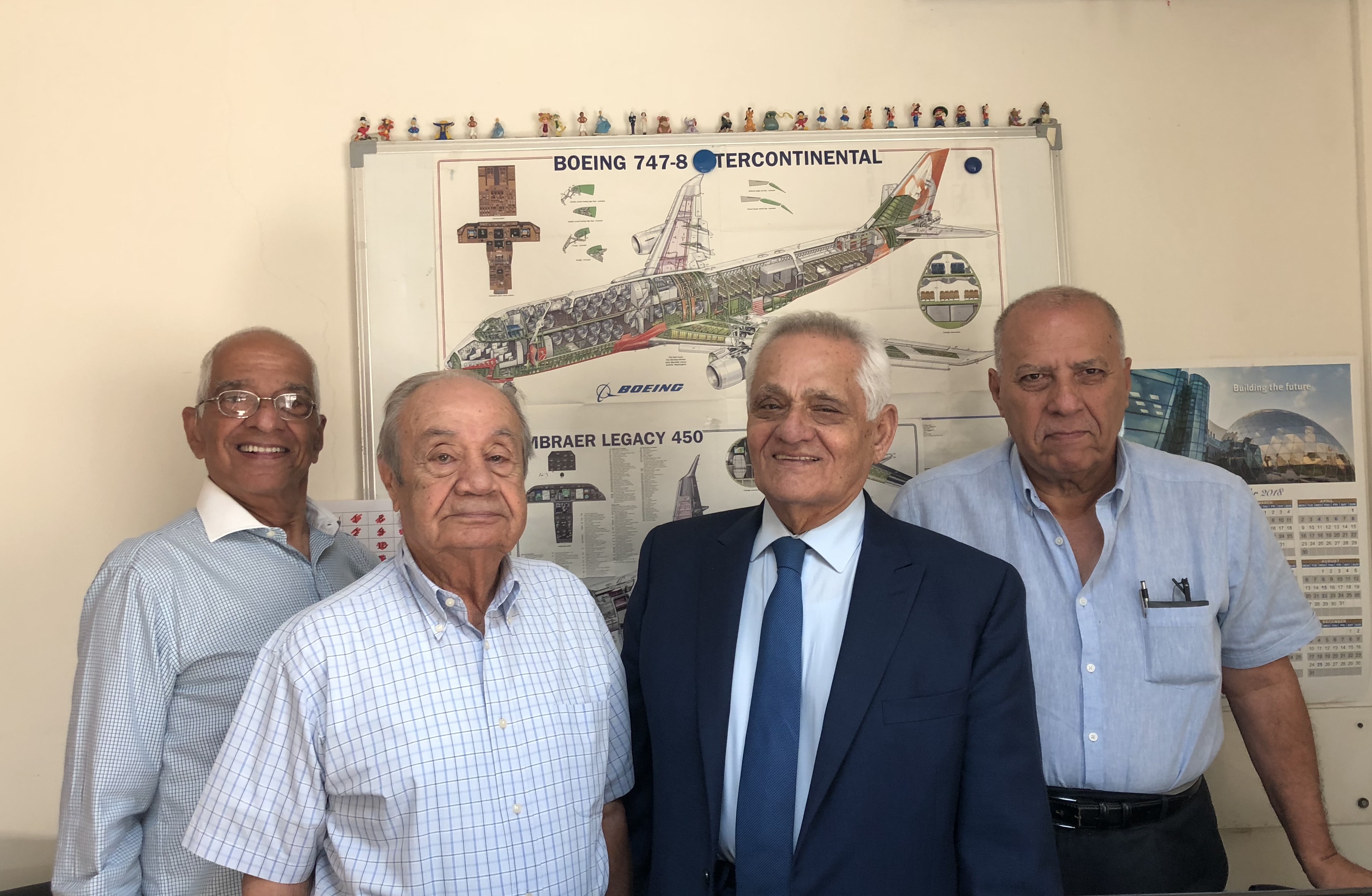
Today Michel Khalifeh, 87, a former colleague of Captain Hoteit’s is also a regular member of his office. The remarkably spry retired MEA steward (and water-skiing champion) recalls his adventures with relish. “I have a total of 32,250 flying hours. I have served 100,000 bottles of champagne. I delivered a baby and have been hijacked twice.”
He and his office mates, like engineer Ramzi El Akel worked side by side throughout the war. For El Akel, MEA symbolized the Lebanon that the government wasn’t able to be: “It was a free place where people worked together. And outside of the country, MEA was like Lebanon’s embassy, people would come to us for help rather than the embassy.”
A year before the war ended, El Akel recalled a power outage at the airport. “MEA bought several generators and provided electricity to the whole airport,” he recalled; “The government eventually paid us back in installments.”
But the airport was in very bad shape by that time, and Buchakjian recalls flying out one night: “There were no lights on the runway. The staircase leading to the plane was lit with a beam coming from car headlamps.”
Once the war ended in 1990, reconstruction work began on the airport and a new terminal was built adjacent to the old one. Though Captain Hoteit and his colleagues offered suggestions for the renovation, they fell on deaf ears, they said; in 1998, along with a change of management at MEA, the old terminal was razed.
Wassim Chemaitilly undoubtedly voiced what many felt: “Being at the airport was never banal. I miss the old airport dearly. It meant hope to me, it was a window to a world to which I thought we belonged, one of civilized nations. There’s always the perception that the airport represented drama, but for me I associate it with happy times.”
On my first visit to Beirut in 1991, a year after the end of the civil war, the old terminal was worn and unpolished but it had gravitas and character, and it was easy to imagine the millions of people who had transited in and out of the terminal, for happy, dramatic or heart-wrenching trips, many going into exile, never to return as residents.
But the new terminal feels impersonal to many, as if an old friend had been replaced. MEA and the old airport had been a symbol of a country struggling for unity; today, Lebanon remains plagued by sectarian discord and Beirut is overshadowed as a hub by Dubai. Passengers pass through, in transit from war-torn Syria and Iraq, or nostalgic Lebanese immigrants on holiday. But the new airport, like the country, has yet to find its identity.
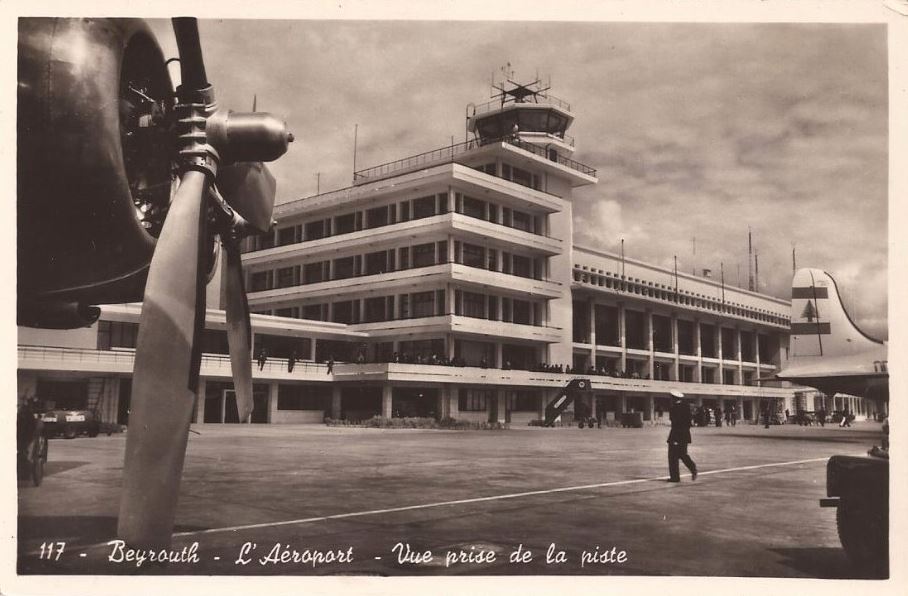 Lebanese Ministry of Tourism
Lebanese Ministry of TourismOlivia Snaije

